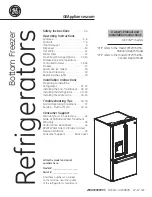
Carrying out the hydraulics installation 6
0020213395_00 flexoTHERM exclusive Installation and maintenance instructions
17
6
Carrying out the hydraulics
installation
1.
If you want to carry out active cooling using ground as
the heat source, make sure that the borehole/ground
sensor is suitable for this purpose and observe the na-
tional directives and laws. The use of ground collectors
for active cooling is prohibited.
2.
Flush the heating installation through thoroughly be-
fore connecting the heat pump in order to remove any
residue which could be deposited in the heat pump and
lead to damage.
3.
Install the supply lines (disconnected from the power
supply) in accordance with the dimension and connec-
tion drawings.
–
Position the pipe brackets for securing the heating
circuit and brine circuit piping so that they are not
too close to the heat pump in order to prevent noise
transmission.
–
If required, instead of pipe brackets, use cold insu-
lation clamps with additional rubber insulation and,
in some cases, reinforced hoses (armoured rubber
hoses).
–
To prevent excessive pressure losses, do not use
stainless steel corrugated pipes.
–
If required, use horizontal or right-angled connection
adaptors from the accessories.
Note
The heat pump's compressor has two-fold
vibration insulation. This eliminates vibra-
tions in the coolant circuit that are inherent in
the system. However, under certain circum-
stances, residual vibrations may occur.
4.
Attach automatic purging valves to the heating installa-
tion.
6.1
Requirements for the heating circuit
In heating installations that are equipped primarily with ther-
mostatic or electrically controlled valves, a constant and suf-
ficient flow through the heat pump must be ensured. Irre-
spective of which heating installation is selected, the min-
imum volume of circulating heating water (35% of the nom-
inal flow; see the Technical data table) must be guaranteed.
6.2
Connecting the heat pump to the heating
circuit
Caution.
Risk of damage from magnetite deposits.
In heating installations with steel pipes,
static heating surfaces and/or buffer cylinder
systems, magnetite may form where large
volumes of water are involved.
▶
Insert a magnetite filter to protect the
pump inside the product.
▶
You must position the filter in direct prox-
imity to the return line to the heat pump.
1.
Install a diaphragm expansion tank at the heat pump
connection provided.
2.
Install an expansion relief valve (at least DN 20, open-
ing pressure of 3 bar) with pressure gauge.
3.
Install the expansion relief valve hose in a frost-free
environment and ensure that its routing ends in an open
tundish where it is then visible.
4.
Install an air/dust separator in the return of the heating
circuit.
5.
Connect the heating flow to the heating flow connection
of the heat pump.
6.
Connect the heating return to the heating return con-
nection of the heat pump.
7.
Insulate all of the pipes in the heating circuit and the
connections for the heat pump so that they are vapour-
diffusion-tight in order to prevent them from falling be-
low the dew point in cooling mode.
6.3
Connecting the heat pump to the brine
circuit
29
71
≥100 mm
42a
65
A
B
29
Brine pump
42a
Brine expansion relief
valve
65
Brine collecting con-
tainer
71
Brine diaphragm expan-
sion tank
A
From the heat source
to the heat pump (hot
brine)
B
From the heat pump to
the heat source (cold
brine)
1.
Remove the blind caps from the brine connections.
These are no longer required and can be properly dis-
posed of.
2.
Connect the brine lines to the heat pump.
3.
Insulate all of the brine lines and the connections of the
heat pump so that they are vapour-diffusion-tight.
Note
Vaillant recommends that you install the
Vaillant heat pump brine filling unit (not
required when installing the groundwater
module). By doing this, it is then possible to
carry out a preparatory partial bleed of the
brine circuit, e. g. the flow and return lines of
the brine circuit to the product.
















































